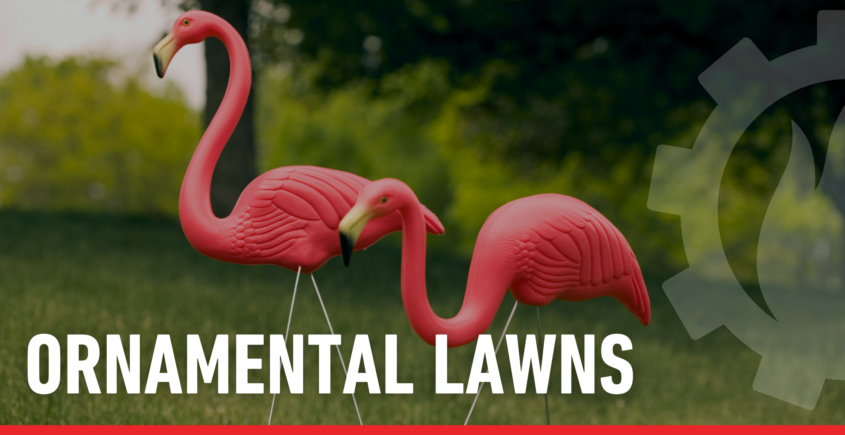Ornamental Lawns
As we began to plan the plants and landscape designs for the spring and season, one thought popped into my head by my sister Peggy (she was even gracious enough to send me a link!) – Who are the people pulling plastic flamingos out of their shed? Scattered throughout our communities, and often part of a Happy Birthday lawn recognition, the proud, bright pink flamingos stand the test of time (battling notoriety with gnomes and wooden cut-out images of someone bending over to garden). To learn more, I went to her link to find some fun info – and of course, then found some additional trivia I just had to share. Thanks to Peggy for the fun info. Enjoy!

By popular demand, we’re now sharing guides for the previous week’s logo contest!
Every Friday, scroll to the bottom of the post to review last week’s guide and see if we managed to stump you.
Fun country song about pink flamingos:
Lawn and park decorations date back centuries. Early examples of the use of garden ornaments in Western culture were seen in Ancient Roman gardens, such as those excavated at Pompeii and Herculaneum. The Italian Renaissance garden and French formal garden styles were the peak of using created forms in the garden and landscape, with high art and kitsch interpretations ever since.
Garden ornamentation includes fountains, pots and urns, religious statues, birdbaths and feeders, sculptures (love sasquatch), sundials, windchimes, and more.
The plastic flamingo lawn ornament was created in 1957 by Don Featherstone, a sculptor working for Union Products in Leominster, Massachusetts. Inspired by real flamingos, Featherstone crafted the design from two halves of molded plastic. The flamingo was chosen because of its bright pink color and exotic appeal, evoking images of Florida and warm coastal climates.
During the 1950s and ’60s, post-war America saw a rise in suburban living, and people wanted unique ways to decorate their lawns and show individuality. These ornaments became instantly popular, symbolizing leisure, tropical vibes, and fun. The rise of kitsch culture embraced bold, colorful, and sometimes humorous home décor and flamingos fit right in.
For collectors, genuine pink flamingos made by Union Products from 1987 can be identified by the signature of Don Featherstone on the rear underside. These official flamingos were sold in pairs, one standing upright and the other with its head low to the ground, “feeding”.
Kitsch is a term applied to art and design that is perceived as naïve imitation, overly eccentric, gratuitous, or of banal taste. The modern artists traditionally opposed kitsch for its melodramatic tendencies, its superficial relationship with the human condition, and its standards of beauty.
In the first half of the 20th century, kitsch was used about mass-produced, pop-cultural products that lacked the conceptual depth of fine art. However, since the emergence of Pop Art in the 1950s, kitsch has taken on newfound highbrow appeal.
By the 1970s, flamingo lawn ornaments became associated with tacky decor, sparking both love and mockery. Many homeowners’ associations and communities banned them, increasing their status as a rebel statement. In Florida, some retirement communities embrace flamingos as mascots, symbolizing the sunny, carefree lifestyle.
Featherstone’s flamingo design remained popular for decades and was even inducted into the Museum of Bad Art as a symbol of kitsch.
In 2009, the city of Madison, Wisconsin, officially declared the pink flamingo its city bird, solidifying its place in pop culture. The city’s soccer club, Forward Madison FC, uses the plastic flamingo on its logo.
Many communities and fundraisers use “flocking” as a fun way to prank friends or raise money. A group of people places dozens of plastic flamingos on someone’s lawn overnight as a surprise. The recipient must usually pay a small donation to have them removed, with proceeds often going to charity or school fundraisers. (love this!!)
Other popular lawn adornments include (no sasquatch silhouettes!):
Gnomes – Originating from Germany in the 19th century, garden gnomes were originally ceramic statues meant to bring good luck to gardens. The tradition spread across Europe, and in the 1930s, gnome production ramped up in the United States. They were popularized in the 1990s and 2000s by “gnome-napping” pranks, where people would steal a gnome, take it on adventures, and return it with photos.
Concrete Goose – A staple of Midwestern and Southern lawns, concrete goose statues became popular in the 1980s. People dress them up in costumes for different seasons, holidays, or just for fun. The trend is believed to have started in Ohio, and the geese symbolize homey charm and humor.
Reflecting Balls – First introduced in Italy during the 13th century, these mirrored spheres were believed to ward off evil spirits. Popular in Victorian England, they made their way to America in the early 1900s. Today, they serve as decorative pieces in gardens, adding an air of mystery and elegance.
Whether loved or laughed at, the pink plastic flamingo continues to be an iconic piece of Americana.
How did you do on last week’s logo contest?
Check out our logo guide for the “Descended From Heat Treaters” post here!






Leave a Reply
Want to join the discussion?Feel free to contribute!